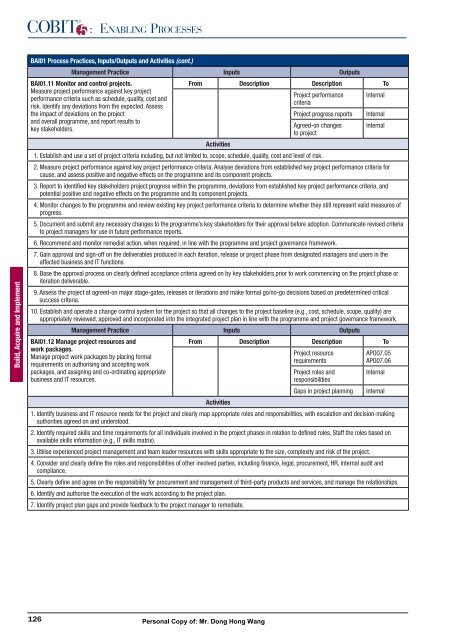Enabling Processes
Enabling Processes
Enabling Processes
You also want an ePaper? Increase the reach of your titles
YUMPU automatically turns print PDFs into web optimized ePapers that Google loves.
Build, Acquire and Implement<br />
126<br />
: ENABLING PROCESSES<br />
BAI01 Process Practices, Inputs/Outputs and Activities (cont.)<br />
Management Practice Inputs Outputs<br />
BAI01.11 Monitor and control projects.<br />
From Description Description To<br />
Measure project performance against key project<br />
Project performance Internal<br />
performance criteria such as schedule, quality, cost and<br />
criteria<br />
risk. Identify any deviations from the expected. Assess<br />
the impact of deviations on the project<br />
Project progress reports Internal<br />
and overall programme, and report results to<br />
Agreed-on changes Internal<br />
key stakeholders.<br />
to project<br />
Activities<br />
1. Establish and use a set of project criteria including, but not limited to, scope, schedule, quality, cost and level of risk.<br />
2. Measure project performance against key project performance criteria. Analyse deviations from established key project performance criteria for<br />
cause, and assess positive and negative effects on the programme and its component projects.<br />
3. Report to identified key stakeholders project progress within the programme, deviations from established key project performance criteria, and<br />
potential positive and negative effects on the programme and its component projects.<br />
4. Monitor changes to the programme and review existing key project performance criteria to determine whether they still represent valid measures of<br />
progress.<br />
5. Document and submit any necessary changes to the programme’s key stakeholders for their approval before adoption. Communicate revised criteria<br />
to project managers for use in future performance reports.<br />
6. Recommend and monitor remedial action, when required, in line with the programme and project governance framework.<br />
7. Gain approval and sign-off on the deliverables produced in each iteration, release or project phase from designated managers and users in the<br />
affected business and IT functions.<br />
8. Base the approval process on clearly defined acceptance criteria agreed on by key stakeholders prior to work commencing on the project phase or<br />
iteration deliverable.<br />
9. Assess the project at agreed-on major stage-gates, releases or iterations and make formal go/no-go decisions based on predetermined critical<br />
success criteria.<br />
10. Establish and operate a change control system for the project so that all changes to the project baseline (e.g., cost, schedule, scope, quality) are<br />
appropriately reviewed, approved and incorporated into the integrated project plan in line with the programme and project governance framework.<br />
Management Practice Inputs Outputs<br />
BAI01.12 Manage project resources and<br />
From Description Description To<br />
work packages.<br />
Project resource<br />
APO07.05<br />
Manage project work packages by placing formal<br />
requirements<br />
APO07.06<br />
requirements on authorising and accepting work<br />
packages, and assigning and co-ordinating appropriate<br />
Project roles and Internal<br />
business and IT resources.<br />
responsibilities<br />
Gaps in project planning Internal<br />
Activities<br />
1. Identify business and IT resource needs for the project and clearly map appropriate roles and responsibilities, with escalation and decision-making<br />
authorities agreed on and understood.<br />
2. Identify required skills and time requirements for all individuals involved in the project phases in relation to defined roles. Staff the roles based on<br />
available skills information (e.g., IT skills matrix).<br />
3. Utilise experienced project management and team leader resources with skills appropriate to the size, complexity and risk of the project.<br />
4. Consider and clearly define the roles and responsibilities of other involved parties, including finance, legal, procurement, HR, internal audit and<br />
compliance.<br />
5. Clearly define and agree on the responsibility for procurement and management of third-party products and services, and manage the relationships.<br />
6. Identify and authorise the execution of the work according to the project plan.<br />
7. Identify project plan gaps and provide feedback to the project manager to remediate.<br />
Personal Copy of: Mr. Dong Hong Wang


